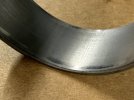Hi all!
I’m new to the forum, have been reading more than posting for the last year.
I’m recovering a 5 door Freelander 1 2.0 Di from 1998. This car has been in the family from new. And has 180000kms
The car was stopped for about 2 years and very neglected…
This year I replaced the head gasket as it was drinking coolant, and started restoring the car.
Today I removed the sump to change the gasket and inside I found aluminum shavings
Does anyone have any idea of what could be?
The car had no noticeable knocking and was working normally.
Could this be dirt from the work on the head done when changing the head gasket?
Does anyone have any idea?



I’m new to the forum, have been reading more than posting for the last year.
I’m recovering a 5 door Freelander 1 2.0 Di from 1998. This car has been in the family from new. And has 180000kms
The car was stopped for about 2 years and very neglected…
This year I replaced the head gasket as it was drinking coolant, and started restoring the car.
Today I removed the sump to change the gasket and inside I found aluminum shavings
Does anyone have any idea of what could be?
The car had no noticeable knocking and was working normally.
Could this be dirt from the work on the head done when changing the head gasket?
Does anyone have any idea?



